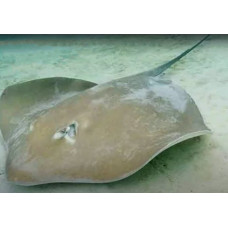Latin name
Pateobatis jenkinsii
Other names
Pateobatis jenkinsii
Identification
The pectoral fins of these rays fuse with the head to form a rhombic flattened disk, 1.1-1.2 times as wide as it is long, the edges of the fins ("wings") being broadly rounded. The triangular snout forms an obtuse angle, its pointed tip protruding beyond the edges of the disc. Behind the medium-sized eyes are oval spiracles larger than the eyes themselves. On the ventral surface of the disc are 5 pairs of gill slits, a mouth, and thin, long nostrils. A flap of skin with a fringed lower margin runs between the nostrils. The mouth is arched, and there are 4 protuberances at the bottom of the mouth. Small, blunt teeth are staggered to form a flat surface.
Tail cylindrical, strongly thinning toward tip, slightly exceeding width of disc. Dermal folds on caudal peduncle absent. On the dorsal surface in the central part of the caudal peduncle is a thin spine connected by ducts to the venom gland. Sometimes stingrays have up to 3 spines. Periodically the sting is broken off and a new one grows in its place. The dorsal surface of the disk has a granular texture and is densely covered with tiny, heart-shaped scales that run in a broad band from the area between the eyes to the tail. One or two rows of large lance-shaped barbs are located in the central part of the disc.
Features of fish fins
The pectoral fins are fused to the head, and the pelvic fins are small and rather narrow.
Fish colouring
Except for spots, coloration of dorsal surface of disc smooth yellowish brown. Tail behind spike gray. Ventral surface of disc white.
Distribution
Widespread but uneven distribution in the tropical waters of the Indo-Pacific region. They are found off the southeast coast of Africa, including Madagascar, off Socotra Island, in the waters of South and Southeast Asia, including the Philippines, New Guinea, and off the north coast of Australia from Ningaloo to the Gulf of Carpentaria.
Habitat
Tropical marine species. These demersal fish are found near shore at depths of up to 100 meters, although they usually do not go deeper than 50 meters. They prefer sandy bottoms. They swim in brackish water.
Size
The maximum registered width of the disk is 150 cm and the total length is 3 m.
Behavior
They occur both singly and in groups. They are sexually segregated. An individual of this species has been observed in Mozambican waters together with Dasyatis microps.
Food and feeding habits
The main food of these stingrays is small bony fish, they also prey on crustaceans.
Reproduction
It is an egg-laying fish. The embryos develop in the womb and feed on egg yolk and histotrophs. The width of a newborn disk is 20-27 cm. In males, sexual maturity occurs when the disc width reaches 75-85 cm.
Fishing
It is a target fishery. They are caught with seines, bottom trawls, gillnets and longlines. They are caught as bycatch in commercial fisheries.
Relationship with a person
The skin of these stingrays is highly prized for its spectacular barbs. Their meat and cartilage are also used.
| Classification | |
| Phylum | Chordata |
| Class | Chondrichthyes |
| Squad | Myliobatiformes |
| Family | Dasyatidae |
| Genus | Pateobatis |
| Species | P. jenkinsii |
| Features | |
| Conservation status | Endangered |
| Habitat | Bottom |
| Life span, years | No information |
| Maximum body weight, kg | No information |
| Maximum length, cm | 150 |
| Sailing speed, m/s | No information |
| Threat to people | Edible |
| Way of eating | Predator |
Jenkins' whipray
Tags: jenkins' whipray



